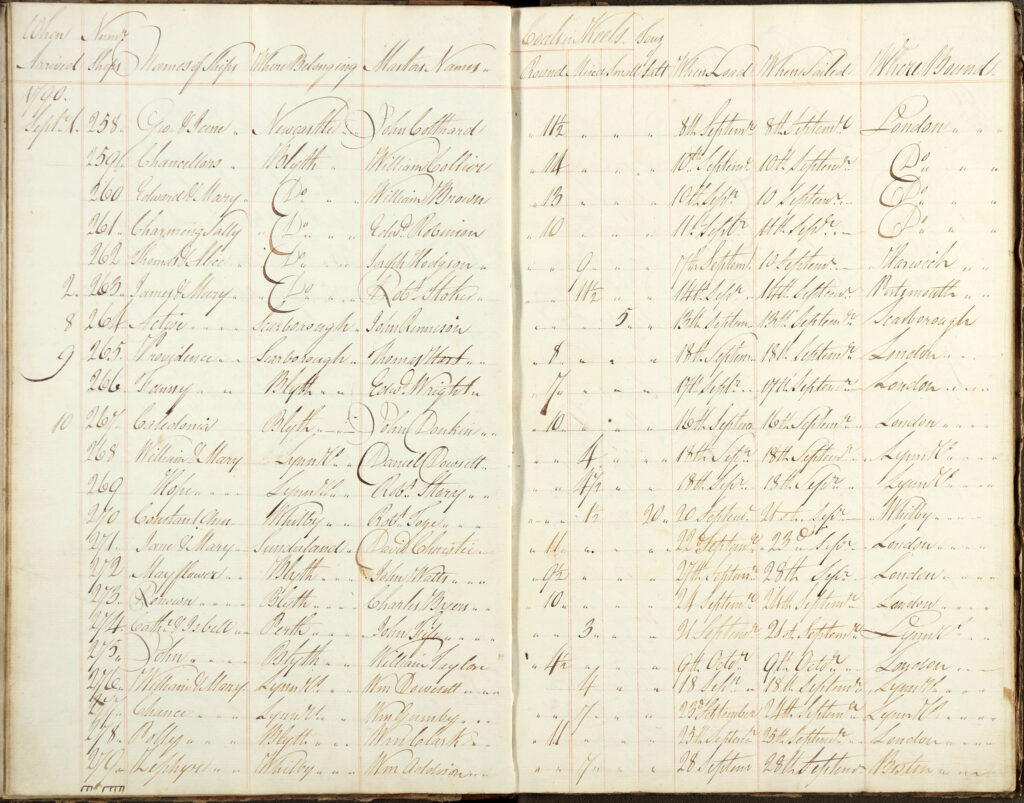Register of Ships Arriving and Departing Blyth, 1790-1794
Reference: ZRI/37/5
Suggested age groups: KS1, KS2, KS3, KS4, lifelong learners
Subject areas: Industrial History, Coal Mining, shipping, Transportation
CONTEXT
This is a page from a register of ships arriving and departing from Blyth. The register is part of the Ridley collection, held at Northumberland Archives. The Ridley family owned lots of the land in and around Blyth, including the harbour area, from the 1720s onwards.
The register records the names of the ships, their port of origin, the masters’ names, the ships’ cargoes, date of loading, date of sailing and port of destination from Blyth. This page records the ships coming into the port 1st-10th September 1790. The volume contains entries that cover the period 1790-1794.
Do = ditto (the same as above)
Keel = 21.54 metric tons of coal, 1 metric ton = 1000kg (see heading of columns 6-8)
Mixed, round, small (heading of columns 6-8) – grades of coal
Keel – also a type of boat used to transport coal, typically used on NE coast
Tons of salt (column 8) – imperial ton = 1016kg
1793 – 343 ships
1794 – 315 ships
Between 1755 and 1767 an average of 165 ships docked at Blyth per year. Between 1793 and 1799 that average rose to 292 ships per year.
(See WR Sullivan Blyth in the Eighteenth Century, Oriel Press, Newcastle, 1971)
Newcastle Journal, 7 Jan 1744
At Blyth, a good sea-port in Northumberland, good convenience for carrying on any trade, with liberty to build warehouses, granaries, and other things necessary; also a new wind-mill, built with stone and well-accustomed; a fire-stone quarry for glass-house furnaces; a draw-kiln for burning limestones; two large sheds for making pan-tiles and stock-bricks, with a good seam of clay for that purpose; also at Link-house, one mile from Blyth, a large new malting, well supplied with water. Enquire at Link-house aforesaid, or of Matthew Ridley, esquire, Newcastle.
ACTIVITIES
ACTIVITY 1
Background
This is a page from a register of ships arriving and departing from Blyth. The register records the names of the ships, their port of origin, the masters’ names, the ships’ cargoes, date of loading, date of sailing and port of destination from Blyth. This page records the ships coming into the port 1st-10th September 1790. The volume contains entries that cover the period 1790-1794.
SEE
See: What is this document?
See: When was this document made?
See: What does this register record?
Think: What types of cargo were the ships carrying?
THINK
Think: What can you infer about trade in Blyth from this document?
Think: What can you infer about Blyth’s port from this document?
Think: What types of industry were prevalent in Blyth during the 1790s?
Think: What types of industry are prevalent in Blyth today?
DO
Do: Create a bar chart recording the ships’ port of origin.
Do: Create a bar chart recording the ships’ port of destination after Blyth.
Do: From your bar charts, find the most popular port of destination after Blyth.
Do: From your bar charts, find the least popular port of destination after Blyth.
Do: Discuss what you can observe about the port based on your bar charts.
Do: Create a map showing where each of the ships travelled to.
Do: Label on the map which ships travelled to which destination.
Do: Research the Port of Blyth today. Can you find where the ships travel to/from and the types of cargo they carry?
Do: Use the Vessel Finder website to find out where ships are arriving from into Port of Blyth today.
Do: Use the Vessel Finder website to find out where ships are departing Port of Blyth to today.
Do: Discuss what types of vessels you have observed in Port of Blyth today. How are these similar or different to the vessels at the Port in 1790?
Do: Research industry in Blyth today. Make a list of the types of industry you come across.
Do: Compare industry in Blyth today to industry in Blyth in the 1790s. How much has changed and how much is similar?
Resources
OTHER ONLINE RESOURCES
Blyth Town website, page about Blyth during late-1700s to early-1800s: https://www.blythtown.net/articles/blyth-during-the-napoleonic-wars-1793-1815-33
Northumberland Archives website, Communities online exhibition, page about Blyth: https://communities.northumberland.gov.uk/Blyth.htm
About Blyth website, page about the history of Blyth: https://aboutblyth.co.uk/blyth-snippets/
Port of Blyth website, page on the history of Blyth: https://portofblyth.co.uk/about/history/


